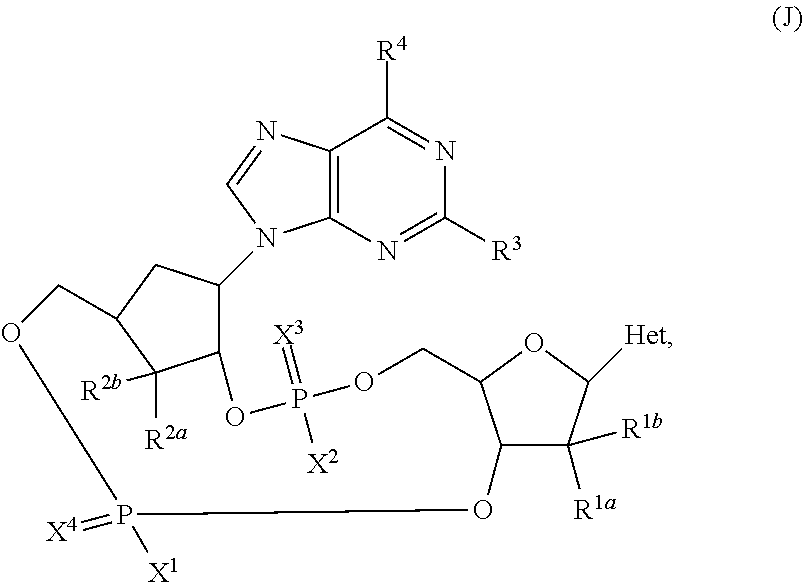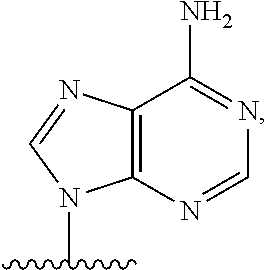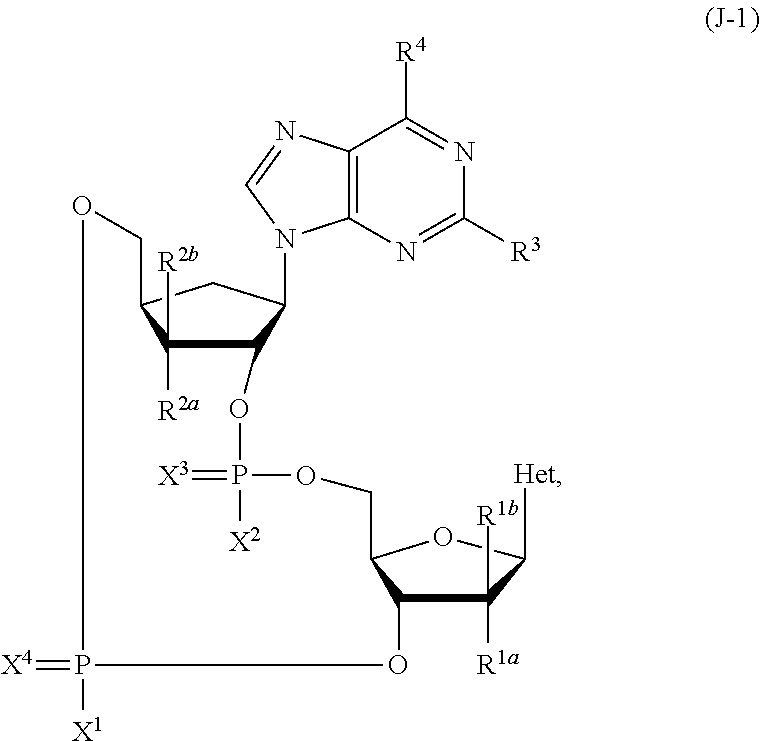2'3'-cyclic dinucleotides comprising carbocyclic nucleotide
- Summary
- Abstract
- Description
- Claims
- Application Information
AI Technical Summary
Benefits of technology
Problems solved by technology
Method used
Image
Examples
example 1
,6S)-5,6-dihydroxy-2-azabicyclo[2.2.1]heptan-3-one (1)
[0887]To an ice-cold solution of (1R)-(−)-2-azabicyclo[2.2.1]hept-5-en-3-one (21.8 g, 0.2 mol) in dioxane (400 mL) was added 4-methylmorpholine N-oxide monohydrate (40.5 g, 0.3 mol) followed by slow addition of OsO4 (0.15 M soln in water, 2 mL). Slow dissolution of NMMO indicated reaction progress, reaction mixture was stirred for 1 h at 0° C. and 2 h at room temperature. Reaction was quenched by addition of sodium bisulfite (30% soln. in water, 5 mL), volatiles were evaporated, crude product was adsorbed on silica, applied on a plug of silica and pure compound was eluted with a gradient of MeOH in CHCl3 (0-20%) to yield the title compound (28.16 g, 98%) as white solid. NMR spectra matched the data in the literature reference J. Org. Chem. 1981, 46(16), 3268.
example 2
,6S)-5,6-bis((tert-butyldimethylsilyl)oxy)-2-azabicyclo[2.2.1]heptan-3-one (2)
[0888]Compound 1 (28.16 g, 0.2 mol) was codistilled with DMF (2×100 mL), dissolved in dry DMF (400 mL) and to this solution was added imidazole (53.6 g, 0.79 mol) followed by slow addition of TBDMSCl (118.6 g, 0.79 mol). After 3 h the reaction was quenched by addition of MeOH (50 mL), all volatiles were evaporated, honey-like residue was dissolved in AcOEt (1.5 L) and washed with saturated solution of NaHCO3 (2×300 mL) and water (300 mL). The organic phase was dried over sodium sulfate and evaporated. Column chromatography (ethyl acetate in petrol ether—20-100%) afforded the title compound (65.8 g, 90%) as clear oil. NMR spectra matched the data in literature reference. Med. Chem., 2005, 48(24), 7675.
example 3
R,4S,5R,6S)-5,6-bis((tert-butyldimethylsilyl)oxy)-3-oxo-2-azabicyclo[2.2.1]heptane-2-carboxylate (3)
[0889]A solution of 2 (38.84 g, 104.5 mmol) in dry THF (500 mL) under argon atmosphere was cooled to −78° C. in a dry ice—acetone bath. To this solution LiHMDS (1M soln in THF, 105 mL) was added dropwise over 10 minutes. After another 10 minutes benzyl chloroformate (22.4 mL, 156.8 mmol) was added dropwise over 10 minutes and the reaction mixture was stirred for another 10 minutes. Still at −78° C. the reaction was quenched by addition of sat. soln. of NH4Cl (50 mL), diluted with AcOEt (1.5 L) and was washed with sat. soln. of NaHCO3 (300 mL) and water (300 mL). Organic phase was dried over sodium sulfate and evaporated. Column chromatography (AcOEt in petrol ether 10-30%) afforded title compound (49.7 g, 94%) as a white solid: 1H NMR (401 MHz, CDCl3) δ 7.43-7.32 (m, 5H), 5.25 and 5.21 (d, J=12.2 Hz, 1H), 4.22 (dt, J=2.2, 1.2 Hz, 1H), 4.15 (dd, J=5.6, 1.8 Hz, 1H), 3.99 (dd, J=5.5, 1.7...
PUM
| Property | Measurement | Unit |
|---|---|---|
| Temperature | aaaaa | aaaaa |
| Temperature | aaaaa | aaaaa |
| Temperature | aaaaa | aaaaa |
Abstract
Description
Claims
Application Information
 Login to View More
Login to View More - R&D
- Intellectual Property
- Life Sciences
- Materials
- Tech Scout
- Unparalleled Data Quality
- Higher Quality Content
- 60% Fewer Hallucinations
Browse by: Latest US Patents, China's latest patents, Technical Efficacy Thesaurus, Application Domain, Technology Topic, Popular Technical Reports.
© 2025 PatSnap. All rights reserved.Legal|Privacy policy|Modern Slavery Act Transparency Statement|Sitemap|About US| Contact US: help@patsnap.com



